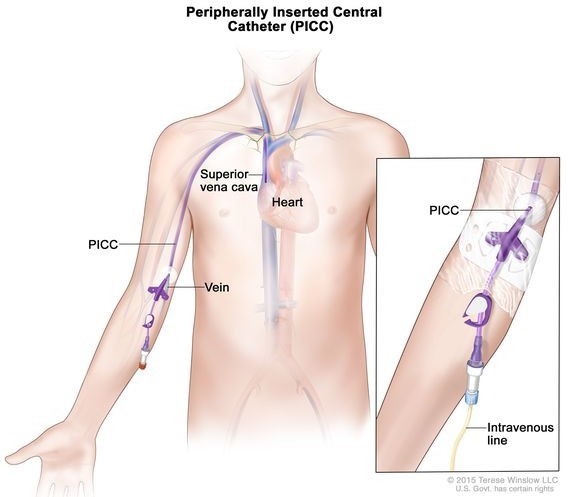A nurse is completing discharge teaching with a client who has a peripherally inserted central catheter (PICC) line in the left arm.
Which of the following instructions should the nurse include in the teaching?
Clean the insertion site using 20 mL of hydrogen peroxide.
Change the catheter dressing daily.
Use a 10-mL syringe to flush the line.
Do not elevate the arm above the level of the heart.
The Correct Answer is C

A 10-mL syringe is the minimum size that should be used to flush a PICC line to prevent damage to the catheter.
Choice A, Clean the insertion site using 20 mL of hydrogen peroxide, is not the correct answer because hydrogen peroxide should not be used to clean the insertion site of a PICC line.
Choice B, Changing the catheter dressing daily, is not the correct answer because the catheter dressing should be changed every 3 to 7 days or as directed by a healthcare provider.
Choice D, Do not elevate the arm above the level of the heart, is not the correct answer because there is no restriction on elevating the arm above the level of the heart with a PICC line.
Nursing Test Bank
Naxlex Comprehensive Predictor Exams
Related Questions
Correct Answer is A
Explanation
Asking the client “What is meant by the saying, ‘Don’t beat around the bush?’” is a way to assess the client’s abstract thinking.
Abstract thinking involves understanding concepts and ideas that are not concrete or tangible, such as interpreting figurative language or proverbs.
Choice B is incorrect because it assesses the client’s memory rather than their abstract thinking.
Choice C is incorrect because it assesses the client’s attention and concentration rather than their abstract thinking.
Choice D is incorrect because it assesses the client’s insight and understanding of their condition rather than their abstract thinking.
Correct Answer is B
Explanation

The priority intervention for a nurse planning care for a client who has status epilepticus is to administer diazepam intravenously to the client.
Diazepam is a benzodiazepine medication that can help stop seizure activity and is often used as a first-line treatment for status epilepticus.
Choice A is incorrect because while phenytoin can be used to treat seizures, it is not typically used as a first-line treatment for status epilepticus.
Choice C is incorrect because while providing oxygen can be an important intervention for clients experiencing seizures, it is not the priority intervention.
Choice D is incorrect because while turning the client to the lateral position during seizure activity can help prevent aspiration, it is not the priority intervention.
Whether you are a student looking to ace your exams or a practicing nurse seeking to enhance your expertise , our nursing education contents will empower you with the confidence and competence to make a difference in the lives of patients and become a respected leader in the healthcare field.
Visit Naxlex, invest in your future and unlock endless possibilities with our unparalleled nursing education contents today
Report Wrong Answer on the Current Question
Do you disagree with the answer? If yes, what is your expected answer? Explain.
Kindly be descriptive with the issue you are facing.
